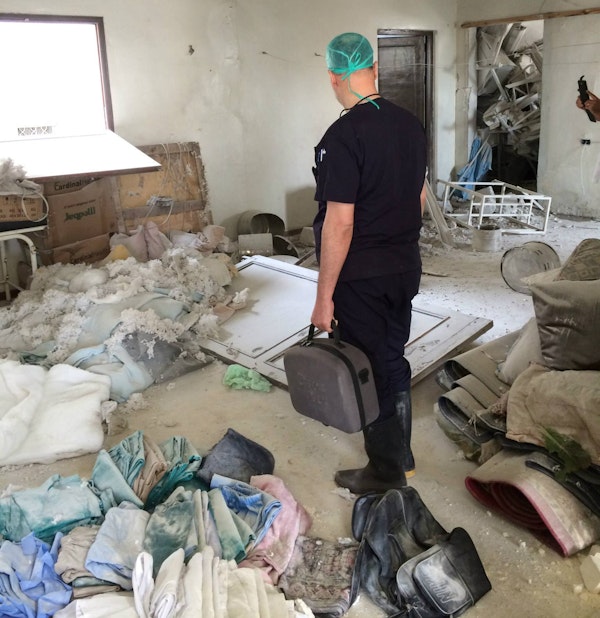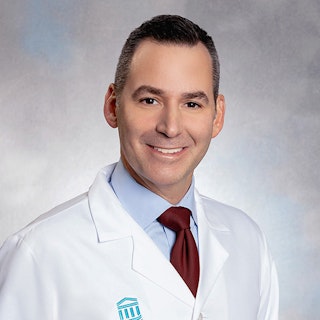Partnerships are Key to Delivering Health Care in Conflict Zones
The war in Ukraine highlights the difficulty of delivering medical care where conflict rages. But wide-ranging partnerships make a difference, helping humanitarians and local organizations provide the care soldiers and civilians alike need in times of war.
 Ambulance crew at the site of the explosion after the bombing of Kyiv in February 2022. (Roman Rvachov/Shutterstock)
Ambulance crew at the site of the explosion after the bombing of Kyiv in February 2022. (Roman Rvachov/Shutterstock)
By now, probably all of us have seen the images of the human costs of Russia’s invasion of Ukraine. So far, an estimated 200,000 soldiers and 17,994 civilians have been directly killed or injured in combat.
Perhaps what we don’t see so often are the indirect impacts of the conflict, the ones that are not directly related to trauma but have a much broader reach. Across Ukraine, six million people already have been displaced from their homes, while seven million more refugees are dispersed throughout neighboring areas of Europe.
In most any conflict, indirect civilian deaths result from a variety of causes. Among them are increased communicable and non-communicable diseases; maternal, neonatal, and nutritional disease; and personal injury. At the same time, food and clean water can become compromised, supply chain disruptions become routine, and loss of shelter, health care, and security abound.
In Ukraine, Russia has directly targeted civilian infrastructure meant to support daily life. The result has been the loss of internet service and electricity, as well as irregular water supply, often during harsh winter months. In addition, armed conflict disrupts the flow of critical social services and health care to local communities.
Ukraine is not alone in this regard. Conflicts across the globe currently impact an estimated 50 million civilians. They also are indirectly related to 1,000,000 deaths each year.
Conflicts in Ethiopia, Yemen, the Sahel, Nigeria, Afghanistan, Lebanon, Sudan, Haiti, Colombia, and Myanmar have each accounted for many of those deaths. They also have led to the destruction of the health of their communities. A troubling shift of warfare from rural to urban settings has compounded these far-ranging impacts of war on humanity.
 Field hospital deployed by a Christian disaster relief organization in Lviv, Ukraine in March 2022. (Bumble Dee/Shutterstock)
Field hospital deployed by a Christian disaster relief organization in Lviv, Ukraine in March 2022. (Bumble Dee/Shutterstock)
The challenges of providing care in conflict
During conflict, an unfortunate perfect storm often arises: The demand for health care increases while the resources for care become scarcer. Greater than 12 million Ukrainians need humanitarian health care, as the system continues to feel the effects of months of active conflict. The challenges of delivering care in impacted areas include logistics, impartiality and neutrality in providing treatment, safety of staff and community, and access to those in need.
Health care workers and systems do their best to adapt, especially since many health care workers, like the general population, are displaced. For example, doctors and nurses who have no prior training in trauma care learn and provide care for the injured. Medical assistants place intravenous lines to give medications, blood, or fluid, a skill that is traditionally performed by nurses who also assume greater responsibility.
During conflict, the demand for health care increases and resources needed for care become scarcer. Greater than 12 million Ukrainians need humanitarian health care, as the health care system continues to feel the effects of months of active conflict.
In Ukraine, challenges to the health care system that existed before the war are now worse. Today, there are already nine million Ukrainians living with chronic diseases that the conflict will surely exacerbate.
As accessibility to primary care becomes more constrained, complications for those with chronic illnesses like diabetes, kidney, heart, or lung disease increase. Routine public health campaigns like vaccinations are often put on hold, too. Syria experienced an outbreak of polio in 2013 and Ukraine is currently experiencing a worsening of its tuberculosis epidemic.
Rates of mental health disorders also dramatically increase, especially in children. Non-emergency surgeries to repair hernias, remove cancerous tumors, or replace failing joints are delayed as surgeons and operating rooms prioritize life-threatening traumatic injuries. Each delay has the potential to cause a cascade of significant impacts on patients and their families or gravely worsen their underlying conditions.
Health care workers and facilities are also often directly attacked. Since the start of the Ukraine-Russian war, the World Health Organization has reported 715 attacks on health care facilities, including hospitals and clinics.
Similarly, Yemen has suffered a loss of 50 percent of health care infrastructure from airstrikes and artillery attacks since 2018. Between 2016 and 2020, 401 health care workers were kidnapped and 681 were killed by combatants between 2016 and 2020 across the globe.
Accessibility to impacted populations is another increasing challenge. In recent years, there has been a steep escalation in the deliberate, willful obstruction of access for humanitarians to assist populations impacted by armed conflict.
Amidst all this destruction, the many actors involved in a conflict – the militaries, international and regional forces, armed non-state actors, and UN peace operations — add complexity to medical care.
In South Sudan in 2021, flooding, poor road conditions, logistical challenges, and damage to infrastructure further compounded an already strained access to care. In all, 591 different incidents limited humanitarian operations and disrupted program delivery and assistance to vulnerable civilians.
Amidst all this destruction, the many actors involved in a conflict – the militaries, international and regional forces, armed non-state actors, and UN peace operations — add complexity to medical care. Combatants have used intimidation and coercion of health care workers to influence treatment and clinical decision-making. Frequent human rights violations challenge clinicians’ ethical frameworks and delivery of medical care. Many examples exist of combatants forcing clinicians to prioritize care for allies or deprioritize patients of certain ethnic or religious groups.
The pivotal role of humanitarians
Fortunately, humanitarians organize, assess, and respond to countries in conflict. Humanitarian organizations can often rapidly provide medical and public health services across diverse environments. They range from establishing vaccination and nutrition programs, delivering primary care in refugee camps, combating infectious disease outbreaks, and establishing field hospitals or rapid training of health care personnel.
Humanitarians traditionally support existing infrastructure and strive to uphold four core principles: humanity, neutrality, impartiality, and independence. Humanitarian international non-governmental organizations (INGOs) are neutral, refraining from taking sides in hostilities or engaging in political, racial, religious, or ideological controversies.
Humanitarians traditionally support existing infrastructure and strive to uphold four core principles: humanity, neutrality, impartiality, and independence.
 A barrel bomb attack in April 2014 on a Syrian American Medical Society-supported hospital in Aleppo. (SAMS/Facebook)
A barrel bomb attack in April 2014 on a Syrian American Medical Society-supported hospital in Aleppo. (SAMS/Facebook)
To operate independently and autonomously, these organizations cannot be subject to control or subordination by political, economic, military, or other objectives. They maintain these ideals in challenging and complex conflict areas and support those providing medical aid. The demanding nature of this work is supported by structure: the United Nations cluster system provides a framework to align strategies, identify gaps, and support collaboration within an affected area.
While humanitarians’ intent to provide relief is clear, measuring impact of humanitarian aid during conflict is difficult. In recent years, academic and humanitarian partnerships have strived to develop novel measures to better develop and understand both positive and negative impacts of interventions.
The successes in delivering care
Collaborative partnerships among academics, humanitarian actors, and community health authorities have emerged, too. Each partner collectively uses their expertise to build more comprehensive approaches to health responses during armed conflicts. Local NGOs and community health workers inform academicians about day-to-day logistics while providing local expertise critical to designing effective interventions that impact outcomes.
Creating equitable partnerships at the outset of a response can provide more sustainable, community-driven efforts to improve care during and after the conflict.
The Syrian data hub, a partnership between the Syrian American Medical Society, the Union for Medical and Relief Organizations (UOSSM), and the Centre for Health and Human Rights at Harvard University is a prime example. The project has organized data from 12-to-15 million patient interactions over five years to better understand and improve how care is delivered. Creating equitable partnerships at the outset of a response can provide more sustainable, community-driven efforts to improve care during and after the conflict.
Local organizations are often the first to assist in conflict, and recent calls have been made for increased localization of humanitarian efforts. Localization in humanitarian aid has many current definitions, but at its core, aims to realign current power structures to strengthen and respect the capacity and leadership of local authorities to better address the needs of affected populations.
Supporters of localization agree that it can improve the speed of delivery services, better interpret needs, and identify existing services. This approach also can bring in expertise to augment local organizations that often serve as the first responders in conflict.
Sending doctors, nurses, and other health care workers to provide direct care and conduct training to develop local health care workers are the two traditional constructs of humanitarian care. For example, our teams at the International Medical Corps, the Harvard Humanitarian Initiative, Mass General Brigham, Boston Children’s Hospital, and the Global Medical Knowledge Alliance have partnered to deliver trauma training courses in Ukraine.
Capitalizing on the use of technology in modern conflict settings has also shown recent success. We have developed a series of brief, just-in-time (JiT) videos that can be readily accessed at a moment’s notice.
These innovative videos are designed for laypersons or public safety professionals, whether health care workers, firefighters, emergency medical services, or law enforcement officers. The goal is to help them learn or refresh emergency care skills.
Digital education has a special advantage in that it can allow for the visualization of complex clinical and public health topics. The use of social media and web-based resources disseminates knowledge in a way that empowers many more providers than just those who are directly trained in classrooms, simulation centers, or hospitals.
Clear, well-captioned videos can help viewers in a number of ways, from recognizing and stopping life-threatening bleeding, to responding to a potential chemical or radiological attack. We are now evaluating the usability, efficacy, and scalability of these JiT videos.
Improving the evidence base for humanitarian health will better identify, expand, and sustain initiatives that improve the lives of those caught in the throes of armed conflict. Ensuring local partner leadership, funding, and engagement is essential. Investing in research capacity, while accounting for ethical and methodological complexity, is also important.
As the needs for global humanitarian response in conflict settings like Ukraine grow, donors and policymakers need to continue to create and support wide-ranging partnerships.
-
Previous Article Addressing Period Poverty Will Expand Access to Health Care Essay by Robert A. McDonald, Former U.S. Secretary of Veterans Affairs and Former President and CEO of Procter & Gamble
-
Next Article Three Paths Toward Improving our Health Care System Essay by Alap Davé, Associate for the Bush Institute-SMU Economic Growth Initiative

